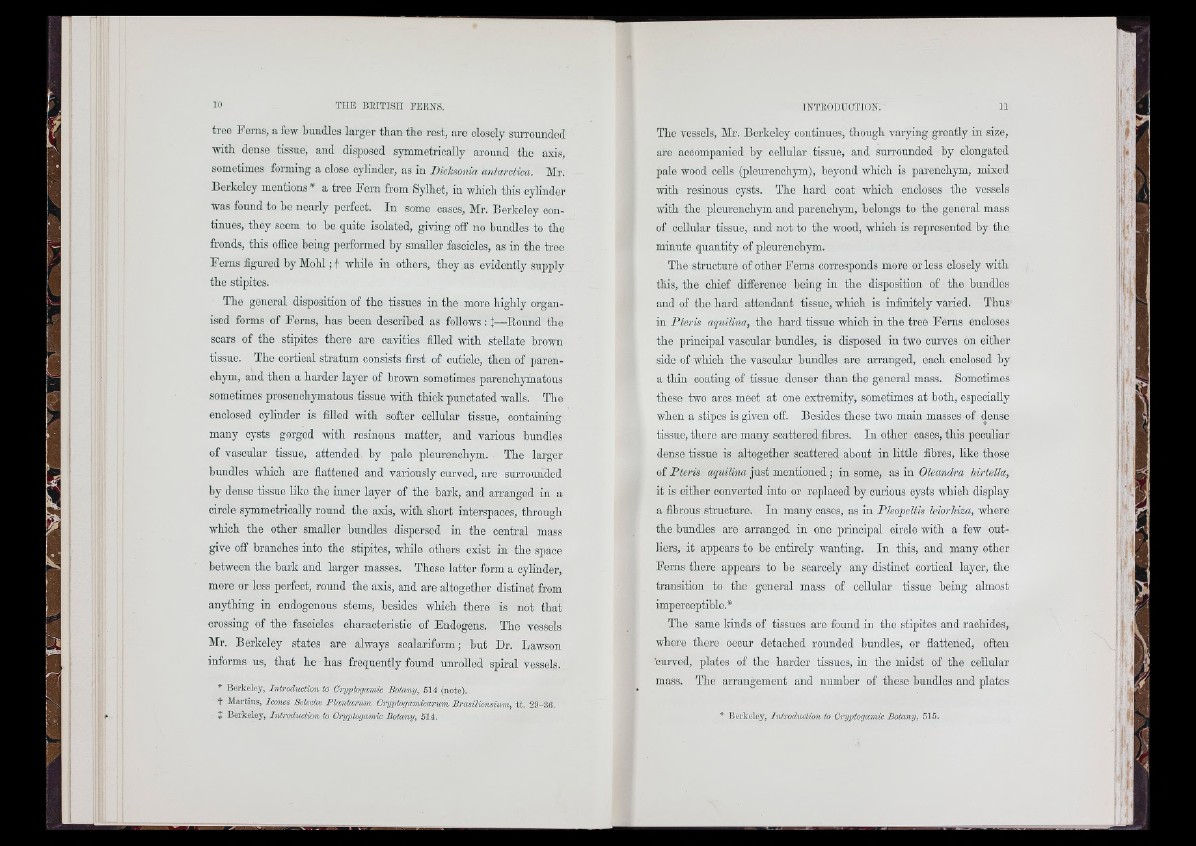
tree Ferns, a few bundles larger than the rest, are closely surrounded
with dense tissue, and disposed symmetrically around tho axis,
sometimes forming a close cylinder, as in Bichsonia antárctica. Mr.
Berkeley mentions* a tree Fern from Sylhet, in which this cylinder
was found to bo nearly porfoot. In some cases, Mr. Berkeley continuos,
they seem to be quite isolated, giving off no bundles to the
fronds, this oifioe being performed by smaller fascicles, as in the tree
Ferns figured by Mold ; t while in others, they as evidently supply
the stipites.
The general disposition of tho tissues in the more highly organised
forms of Ferns, has been described as follows : I—Round the
soars of the stipites there aro cavities filled with stoUate brown
tissue. The cortical stratum consists first of cuticle, then of paren-
chym, and then a harder layer of brown sometimes parenchymatous
sometimes prosenohymatous tissue with thick punctated waUs. The
enclosed cylinder is filled with softer cellular tissue, containing
many cysts gorged with resinous matter, and various bundles
of vascular tissue, attended by pale pleurenchym. The larger
bundles which are flattened and variously curved, aro surrounded
by dense tissue like the inner layer of the bark, and arranged in a
circle symmetrically round the axis, with short interspaces, through
which the other smaller bundles dispersed in the central mass
give off branches into the stipites, while others exist in the space
between the bark and larger masses. These latter form a cylinder,
more or less perfect, round the axis, and are altogether distinct from
anything in endogenous stems, besides which there is not that
crossing of the fascicles oharaoteristio of Endogens. The vessels
Mr. Berkeley states are always scalariform; hut Dr. Lawson
informs us, th a t he has frequently found unrolled spiral vessels.
* Berkeley, Introdiwtion to Cryptogarmo Botany, 514 (note).
+ Martins, lames SeUxtto Pla n ta rum Cryptogamicarum Brasiliensium, tt. 29-36,
Í Berkeley, Introduction to Oryptogamie Botany, 614,
The vessels, Mr. Berkeley continues, though varying greatly in size,
aro accompanied by cellular tissue, and surrounded by elongated
pale wood colls (pleurenchym), beyond which is paronchym, mixed
with resinous cysts. The hard coat which encloses tho vessels
with tho pleurenchym and parenchjmr, belongs to the general mass
of cellular tissue, and not to the wood, which is represented by the
minute quantity of plouronchym.
The structure of other Ferns corresponds more or less closely with
this, the chief difference being in the disposition of the bundles
and of tho hard attendant tissue, which is infinitely varied. Thus
in Pteris aquilina, the hard tissue which in the tree Ferns encloses
the principal vascular bundles, is disposed in two curves on either
side of which the vascular bundles aro arranged, each enclosed by
a thin coating of tissue denser than the general mass. Sometimes
these two ares moot at ono extremity, sometimes at both, especially
when a stipes is given off. Besides these two main masses of dense
tissue, there aro many scattered fibres. In other cases, this peculiar
dense tissue is altogether scattered about in little fibres, like those
of Pteris aquilina just mentioned ; in some, as in Oleandra hirtella,
it is either converted into or replaced by curious cysts which display
a fibrous structure. In many cases, as in Pleopeltis leiorhiza, where
the bundles aro arranged in one principal circle with a few outliers,
it appears to bo entirely wanting. In this, and many other
Ferns there appears to be scarcely any distinct cortical layer, the
transition to the general mass of cellular tissue being almost
imperceptible.*
The same kinds of tissues are found in the stipites and raohides,
where there occur detached rounded bundles, or flattened, often
'curved, plates of the harder tissues, in the midst of the cellular
mass. Tho arrangement and number of these bundles and plates
Berkeley, Introduction to Cryptogamie Botany, 515.